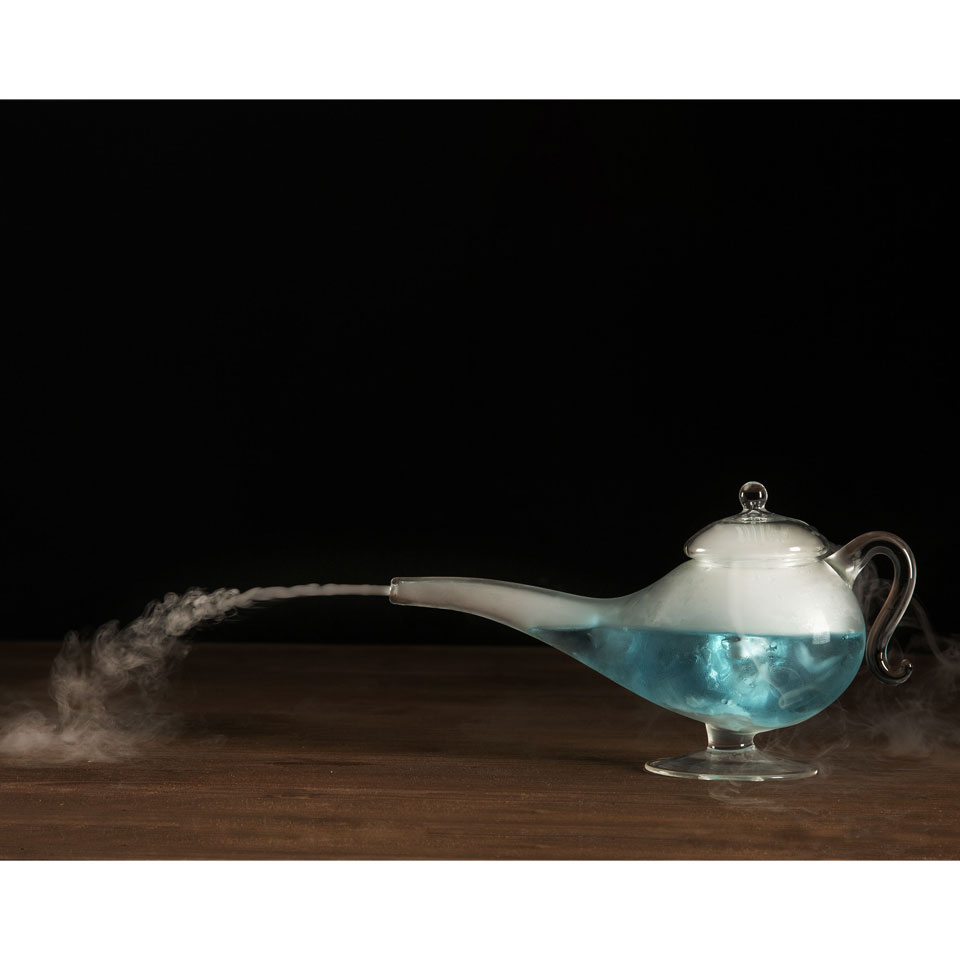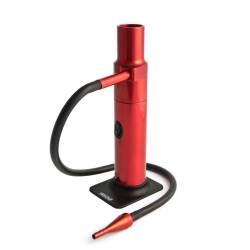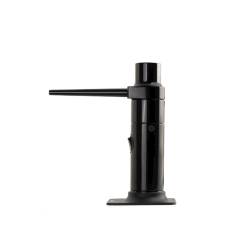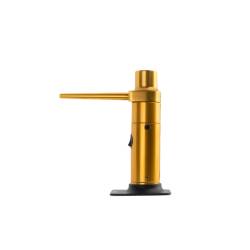In 2003 the first Madrid Fusión congress was held and it was there that the smoking pipe was used for the first time. Brothers Joan and Jordi Roca surprised everyone by using it on their plate of octopus on transparent film, from where balls of aromatic paprika smoke came out every time the diner took a piece of the plate with a spoon. It was the first time cooks used smoke as an olfactory element while tasting a dish.
What was the origin of the smoking pipe?
In 2004, in Barcelona, the gourmet bookstore Buffet & Ambigú in the Mercat de la Boquería launched the first smoker or smoking pipe on the market. This smoking device that fits in one hand was basically a pipe for smoking weed.
However, the smoker had a big problem: its plastic propeller melted because the sawdust bowl was too close to the propeller, and the heat of the blowtorch damaged it with continuous use. To solve this problem, 100% Chef found a solution: extend the length of the device by using an aluminum tube. What resulted was the first Aladin. This was followed by the creation of the first aluminum tube, using the engine of the first-born Aladin: this first model was called the Aladin Pro, first sold in 2005 and arrived at RG as early as 2006.
The creation of the Super Aladin
After their launch, these smoker models began to be in high demand by chefs around the world who wanted to experiment with new olfactory sensations in their dishes. It was then, in 2006, that the first Super Aladin was introduced to the market, a patented all-metal model that allowed the production of aromatic and cold smoke.
This innovative device allowed the addition of cotton soaked in aromatic oils under the combustion chamber.
The first bells with valve for smoking dishes
In 2007, the first borosilicate glass domes specifically for smoking with Aladin were launched.
In 2008, Chef Jordi Cruz advised the 100% Chef team to cut a hole in the hoods to facilitate smoke entry. Thus was born the first hood with a valve, which in the same year was patented as Aladin Cover.
In the same year, the device became so popular in Japanese culture that it even included a special chapter in a manga magazine explaining how to use the new bells.
This smoker was a pioneer and laid the foundation for the development of other models of horizontal smoking guns, such as those made by Polyscience in the United States.
The first Aladin Aromatic
In 2011, Aladin Aromatic was launched, an aroma maker based on contaminating the air inside the containers with aromatic oil.
Then in2012, through the implementation of various technical improvements, the new Aladin 007 was introduced to the market to coincide with the 50th anniversary of the first "Agent 007 vs. Dr. No" film
The launch of the new Aladin 007 was a response to requests from several bartenders who were already using the Super Aladin model to smoke their cocktails. Some of these bartenders include Antonio Lai in Hong Kong and Javier Caballero in Barcelona, Dario Comini Notthingham Forest in Milan.
This new version of the smoker was designed with aesthetics in mind and the need to create an elegant image at the bar, which involved a revamp in terms of image, size, and color.
Concurrently with this launch, the Aladin CD smoking disc was introduced. This perspex disc contains a valve in the center and is used to infuse smoke into drinks, ice, tartare, pickles, desserts, oils, and more. This allows bartenders to add a smoky touch to their cocktail creations.
Subsequently, new borosilicate glass bells specifically for smoking cocktails emerged, such as Aladin Cocktail and Aladin Long Drink, offering additional options for perfecting the art of cocktail smoking.
Over the years, improvements have been made to the smokers to make them easier to use and maintain.
The cocktail bar as a source of inspiration
The cocktail bar has continued to be such a source of inspiration for 100% Chef that it led to the development of the Aladin Station. This device is designed to keep the smoker in a horizontal position, making it safer and more comfortable when filling hoods.
In addition, Aladin Station has the advantage of disposing of resin residue released during combustion in a container, which simplifies cleaning and maintenance of the smoker.
The genius of Aladdin
In 2021 it is the turn of theAladin Genius, a small smoker that allows the smoke to be encased in an elastic film (soap-like) inside a bubble and deposited on drinks and dishes, which bursts releasing its aroma and visual effect.
007 Flavour Aladin: the aroma gun with aromatic vapors.
In2023, to coincide withInternational James Bond Day, the innovative 007 Flavour, a new flavoring device that allows nicotine-free vapers to attach to the head of the device, is launched. It also allows for easy flavor changes, maintenance, and the use of rechargeable batteries.
The 007 Flavour represented a real development-easier to use, cheaper, and more robust-than its predecessor on the market, the popular and market-leading Flavor Blaster®. In addition, a large collection of flavors and a refillable vaper were launched to complete the range.
In addition, this presentation included new illuminated bells, such as the Light Year and theAladin Long Drink Tube, which allow the aromatic vapors and smoke from burning sawdust to be given color, adding an attractive visual element to the flavor experience.
And we come to 2024, the 20th anniversary of the launch of the first manual cold smoking apparatus.
Cold smoking techniques for food and beverages and choice of chips
It is essential to understand the basic principles of cold smoking techniques. First, start with a simple recipe. The best ingredient to start with may be a fatty fish, such as smoked salmon.
Once you know how cold-smoking techniques for food and beverages work, you can apply them to any recipe. Use different types of wood to add different flavors that recall the fruits of the tree you choose. Wood chips for hand smokers should release a low amount of residual resin.
In addition to classic flavors such as oak, beech, or Jack Daniel's barrel, the most popular ones are:
Olive
Aladin Chips Olive is the best choice for smoking fish, lamb and poultry. Pair it with citrus to soften and complement the flavor.
Orange Tree
Orange Tree Chips add a pleasant citrus sensation to smoked bluefish and vegetables. Try pairing them with a gourmet mayonnaise, with some fresh herbs such as tarragon.
Quebracho
The authentic Argentine taste of asado. Quebracho is the best choice for smoking barbecue, red meat, and any roasted meat in general.
Almond
With its nutty, rounded flavor, almond flake smoke can also be used to flavor creams and royale. Play with it to create unique sweet and savory recipes.
Avoid common mistakes and problems
Sometimes, using smoke for food and drink can be tricky. If you use smoke to flavor recipes, you must make sure that its predominant flavor does not override other flavors. The taste may suffer if combustion is not complete. Also, if the wood burns too fast, it will produce an acrid taste.
Never use a wood that is not intended for smoking food. Do not overlook that some types of wood are poisonous! In addition, it is necessary that the wood be certified for food contact. It must not be painted or treated. Because then you might cause harm to your customers! In addition, the taste would be bad.
The best way to lighten the flavor of a smoked dish is to let it rest for a while. The excess smoke will be dissipated. Keep in mind that smoke has a pungent and lingering odor. This means that you will have to choose special containers dedicated to smoking food.
The perfect technique, step by step
Smoking in the kitchen is a very simple technique to master, but a few tricks must be taken into account in order to perform the flavoring properly and safely for the customer. Cold or instant smoking is done just before table service.
What are the 5 steps to smoking properly?
The smoking process depends on many factors and involves the knowledge and integration of several techniques. In detail, by subjecting foods to the action of smoke:
- We facilitate its preservation by dehydration, eliminating the germs responsible for putrefaction through a chemical reaction.
- We give food a distinctive and special flavor and color by communicating the substances that are released from the wood
The smoking process considers three factors:
- Smoke temperature
- Moisture of the smoke
- Origin of the smoke
Step 1: Dry brine
Dry curing is used when the pieces to be smoked are large, such as pork thighs or loins, while brine is used when small pieces, such as fish, are to be smoked. Brine is to apply a thick layer of dry, granulated or refined sea salt over the entire surface of the meat, taking care that no area is left uncovered and deposited in a nonmetallic container with a lid because the PH is greatly lowered and can react with metals. Finally, an excess of salt is applied to cover and ensure that it performs its dehydrating function for the appropriate time, which depends on the size of the pieces and the type of meat to be salted.
For example, a trout weighing about 600 grams should be salted for about 8-10 hours, while a pork loin weighing about 2.5-3 kilograms should be salted for three days.
Recommended brine mixture (use about 250 g of mixture per kg of meat):
1 kg of salt
2 kg of sugar
½ kg garlic salt or flavored salts
½ kg brine salt, nitro salt or sodium nitrate (NaNO3)
herbs (bay leaves, thyme and marjoram)
Sugar prevents the product from being too salty and imparts a slightly sweet flavor. Garlic salt imparts flavor to the meat, and sodium nitrate not only improves the flavor of the meat but also gives it a desirable light pink color. Finally, herbs also play their part in terms of smell and flavor.
Step 2: Wet brine
Wet brine involves preparing a concentrated salt solution (70 or 80 percent salt solution or 114 grams of salt per liter of water) or until a potato or egg floats. Sugar, garlic salt and/or herbs can be added to the wet brine for seasoning.
Step 3: Rinse
This step involves removing the meat from the salt and soaking it in natural water for one to five hours. Depending on the size of the pieces, the water will extract excess salt and slightly rehydrate the meat. After this time has elapsed, the product is removed from the water and allowed to drain for a few minutes.
Step 4: Seasoning
To impart a spicy flavor to the meat, protect it from insects that may settle on it and verminate it with their larvae, and prevent the establishment of bacteria and fungi due to the antibiotic effect of its essential oils, the entire surface of the meat is covered with a thick layer of a mixture of black pepper powder, coarse pepper and paprika or smoked paprika. This step is facilitated by the fact that the meat contains a certain degree of moisture that allows the powders to adhere to its surface.
Step 5: ripen
The last step is the simplest. It consists of removing the meats from the smoker and hanging them in the air for a few days so that they lose the high concentrations of aromatic elements acquired inside the smoker, and the flavors are balanced from the first consumption of the product.
This process, although simple, is not without its cautions, since it must be carried out in cool, shady and well-ventilated places, as well as at times when the relative humidity of the air is low, otherwise the food could gain moisture instead of losing it and over time contribute to the development of fungi or bacteria that, in addition to giving it an ugly appearance, could deteriorate its quality. In the case of fish such as salmon, we can provide a ripening period in a bucket in the refrigerator and ventilate it from time to time.













